When big film franchises are discussed, the likes of Star Wars, Marvel, or Harry Potter may come to mind. But, pre-dating all of them and exhibiting subversive storytelling from the very beginning is the Planet of the Apes franchise. Nearly 60 years after the release of the original film, the franchise continues with Kingdom of the Planet of the Apes, the whopping tenth film in a franchise that has evolved much like the apes at the center of the movies.
The Planet of the Apes movies can be categorized into three blocks. The first in the original series of films, which began with 1968’s Planet of the Apes. Directed by Franklin J. Schaffner and based on the novel by Pierre Boulle, this first film was groundbreaking for its innovative prosthetic makeup techniques and concluded with one of cinema’s great final shots. This first block of films in the original series continues with four sequels to the 1968 classic with Beneath the Planet of the Apes in 1970, Escape from the Planet of the Apes in 1971, Conquest of the Planet of the Apes in 1972, and Battle for the Planet of the Apes in 1973. Dwindling acclaim and poor box office led to a halt in Apes movies from 1973 all the way until 2001. In the new century, Tim Burton helmed a largely panned remake of the original film. After the remake, the third block of Planet of the Apes films, comprised of the prequel or reboot movies, kicked off with 2011’s Rise of the Planet of the Apes, which chronicled the start of the pandemic that eventually led to the world seen in the original movie. Rise was followed by the beloved Matt Reeves duo of films Dawn of the Planet of the Apes and War for the Planet of the Apes. Now, director Wes Ball steps into the director’s chair to take the franchise forward in Kingdom of the Planet of the Apes.
While varying greatly in quality and narrative, the Planet of the Apes movies are nothing if not captivating. Here are our rankings of the 10 films of the Planet of the Apes franchise.
10. Planet of the Apes (2001)
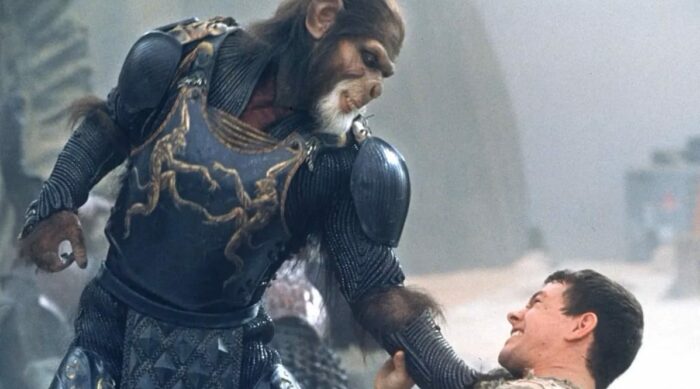
Tim Burton’s Planet of the Apes remake was an attempt to kick off a new era for the franchise, one that would take the classic story and show it with even more depth and scale. With improved makeup and a higher budget to show the scale and advancement of the ape society, Burton had all the tools to make a great entry in the series. Unfortunately, it didn’t quite turn out that way.
Comparisons will rightfully be focused on Burton’s film matches up against the 1968 original, with the 21st century ultimately not coming anywhere close. One could argue that it’s unfair to pit a film against one of the all time classic stories in American cinema as the original is, but the fact remains that the 2001 iteration failed to do anything particularly unique (bar the memorable, if ever confusing, ending). Improved makeup and practical effects aside, Burton’s film doesn’t best out the original in any other way.
Take a look at each film’s star, for example. Charlton Heston led the 1968 Planet of the Apes, playing an astronaut stranded on what he believed to be an alien world. With his performance, Heston gives some of the most crucial moments in the script an even added boost from his charm and classic movie star style. Classic lines such as “it’s a madhouse!” and “get your hands off of me, you damn dirty ape!” are conveyed with the character’s simultaneous desperation to return home and his feelings for those who captured him. Compare that performance with Mark Wahlberg’s, who plays the lead in the Burton directed feature. Ironically, Wahlberg’s turn in this movie serves as evidence as to why he’s better suited to comedic and lighthearted roles, rather than a deeply thematic sci-fi film like this. His continual reference to the baby chimpanzee in his care as a monkey feels not only disrespectful to the core pieces of the story, but also comes off as humorous in a way that doesn’t match with what the film should have been.
That being said, props must go to Burton for the film’s twist on the ending. Rather than seeing the Statue of Liberty, audiences see a monument of Abraham Lincoln, only with the features of an ape. When thinking about it, the concluding scene doesn’t make a ton of sense, but it still serves as an epic and enthralling ending nonetheless.
9. Beneath the Planet of the Apes (1970)
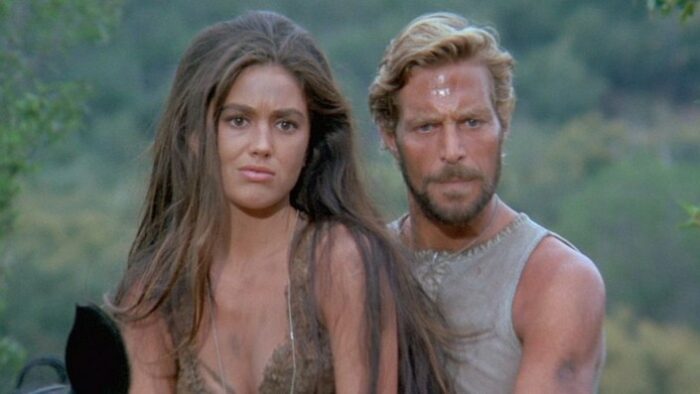
The follow up to the 1968 original failed to reignite the spark that the first film had in abundance. Much of these shortcomings can be attributed to the absence of key players from the original. Rod Serling, who co-wrote the 1968 film, was busy and couldn’t return to write its sequel, and Charlton Heston was reluctant to return. He eventually did, albeit in a supporting role towards the end of the film. Roddy McDowall also doesn’t appear, and his absence is felt greatly too.
The response to the host of changes is a huge part of the issue. In replacement of Heston is a lookalike, playing a different character who is essentially a replica of Taylor; he comes to Earth, is captured by the apes, and falls in love with the same human that Heston did in the first. When Heston finally comes back into the story, he abruptly becomes the lead hero once more, and any previous character development (which was sparse anyway) is thrown out the window.
What’s more, this film isn’t even focused on the apes. They feel more like a side plot than the main thing, as the story transitions to a group of humans living underneath the ground who worship the atomic bomb. Despite the effort to have a political and social commentary on the usage of nuclear weapons in the real world, this plot line ends up feeling out of left field and ultimately falls flat entirely, as does the ending. In typical 1970s sci-fi fashion, Beneath the Planet of the Apes ends on an incredibly bleak and dark note, as Heston opts to destroy the entire world with a nuke. The screen goes white as a result of the bomb, and the credits roll.
8. Conquest of the Planet of the Apes (1972)
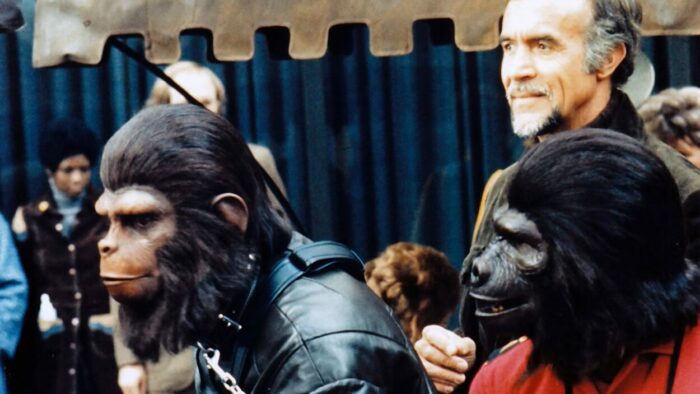
The fourth film in the original set of movies, Conquest of the Planet of the Apes follows Caesar, the son of time traveling apes Cornelius and Zira. The humans of the 1990s discover that an intelligent ape exists on the planet, leading to a huge manhunt to discover where he is. Caesar ends up hiding in plain sight, serving as a slave to the humans, as all apes do in the world at this time (dogs and cats had already been wiped out by a virus, setting up the downfall of the human race).
The main issue with Conquest is that it’s relatively uneventful. Much of the film sees Caesar hiding among the other, less intelligent apes, before he eventually stands up and leads a revolt against the humans (not unlike Andy Serkis’ Caesar does in Rise). The final act picks up as the tension between Caesar and the humans reaches a boiling point, but it almost feels as if the filmmakers were unsure of how to fill the time until they got to that point in the story. That being said, the returning Roddy McDowall, now playing his original character’s son, does an excellent job here once again. With all the talk of Andy Serkis’ excellent performances across three Ape sequels, it shouldn’t be forgotten that McDowall also carried this franchise in the way Serkis did later on.
7. Battle for the Planet of the Apes (1973)
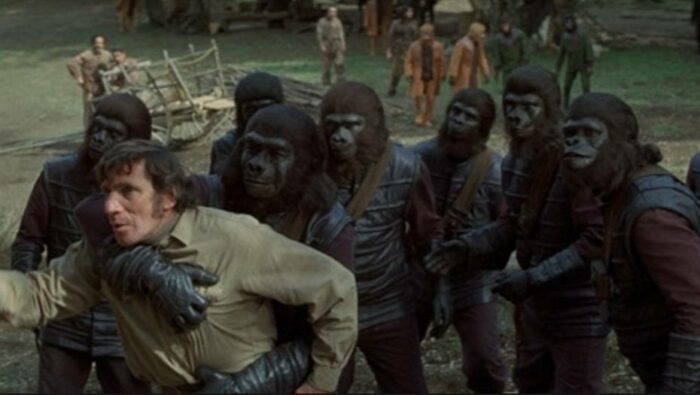
Battle for the Planet of the Apes is the fifth and final installment of the original run of films and sees a developed ape society led by Caesar, with a group of radiation poisoned humans living amongst the rubble of a fallen city. When the humans discover the apes, they come out of their den to hunt them down, leading to another battle for control of the planet.
Battle plays with some incredibly interesting themes throughout, many of which surround how the apes treat the humans that live amongst them. Although not directly slaves, these humans are notably below the apes in the society, just as the apes were once below the humans, which begs the question of just how different these two species are from one another after all. Battle also deals with nuclear blast survivors much better than Beneath (although the latter were more worshippers than they were survivors, as the actual humans to have escaped the blast would have been their ancestors). In Battle, they don’t necessarily worship the atomic bomb, but its detonation sent human society into a dark and desolate place (both physically and metaphorically).
The ending of Battle for the Planet of the Apes makes this installment even more interesting. A few hundred years into the future, an orangutan reads the story of Caesar to a group of young apes and humans, implying that the rift between the species has been resolved and they are now finally able to live side by side. However, the camera then pans over to a statue of Caesar, revealing a single tear streaming down his face. The perceived peace of the society comes into question, ending the original franchise run on something of a cliffhanger, a bold decision that makes Battle even more memorable.
6. Escape from the Planet of the Apes (1971)
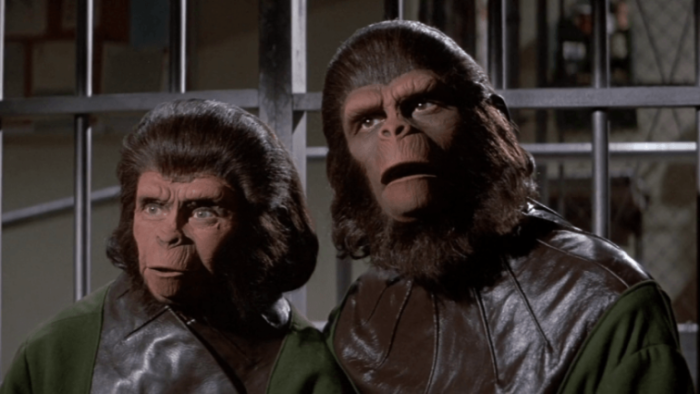
Escape from the Planet of the Apes is arguably the best sequel to the original Planet of the Apes. It features the return of Roddy McDowall and has a plot that is just as innovative and original as the first movie, with Cornelius and Zira passing through the same time vortex that Taylor did, ending up on Earth in the 1970s.
Once again, as is typical for this series, Escape is at its best when it focuses on and continues some of the core themes from the original. The apes come in peace, and some humans are receptive to their arrival, while others are in complete opposition, so much so that they believe the apes should be killed in an attempt to stop the world from becoming what it ends up being in the original. This film reintroduces time travel to the series in a unique and exciting way, and completely reinvents the franchise by going to a world much more familiar with audiences. It still retains its sci-fi elements, though, and features a level of dystopian-ness that makes it a worthy sequel—or, depending on which way you look at it, a prequel.
5. Kingdom of the Planet of the Apes (2024)
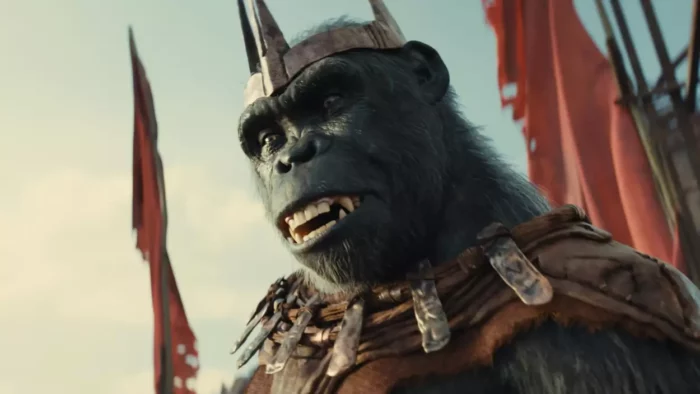
Coming in at number five is the franchise’s latest, Kingdom of the Planet of the Apes, from director Wes Ball. Set 300 years after the fall of Caesar (Serkis’ iteration), Kingdom follows a young ape named Noa who goes on a quest to rescue his family, meeting some questionable human and ape counterparts throughout.
Arguably the biggest positive of Kingdom is the way in which it deals with the legacy of Caesar. Rather than turning a blind eye to the events of the previous trilogy, Wes Ball embraces the work of Andy Serkis, Matt Reeves, and co., showing how Caesar’s work has impacted the world centuries later. In doing so, the core themes of Kingdom become not only more interesting, but relevant to the real world as well. A commentary on religion, Kingdom shows two sides of faith; one is Raka, a devout follower of Caesar who takes his word and beliefs as fact, and Proximus Caesar, who uses the past leader as a way to get other apes to follow him on his bloody quest for power and control. Seeing the contrast between these characters that Noa encounters on his journey highlights the complexity of the world he lives in, making the story even more interesting for audiences.
Kingdom also plays with human characters in an interesting way. Despite the virus mutating to make humans primitive once more in War for the Planet of the Apes, there are still some surviving members of the species who are able to speak, such as young Mae. Without too many spoilers, Kingdom reverses the contrast done with Raka and Proximus, instead comparing the latter with Mae, continuing the franchise’s consistent exploration of how similar or different the two species are. Having more intelligent humans feels like a slight undoing of Matt Reeves’ work in the previous story, however.
4. War for the Planet of the Apes (2017)

Matt Reeves’ trilogy-capper, War for the Planet of the Apes, shows Caesar’s final stand against the humans in a conflict that bonobo Koba began a decade prior. War is the most emotional gut-wrenching of any of the Planet of the Apes films, with scene after scene of epic moments and tear-inducing events. Caesar’s death is emotional, but it’s far from the only scene of its kind in the film, and it’s debatable if this is indeed the most moving scene of the movie. There’s also the apes regaining their faith in Caesar as they sit in jail, showing them perform the apes together strong sign that shows their togetherness in the face of adversary. The gorilla nicknamed Donkey also sacrifices his life towards the end of the film, finally turning against the humans he had worked for and saving Caesar’s life in the process.
With all of this emotion, War is a heavy film, serving as an important yet difficult experience exploring how the planet fully turned on its head to be ruled by the apes.
3. Rise of the Planet of the Apes (2011)
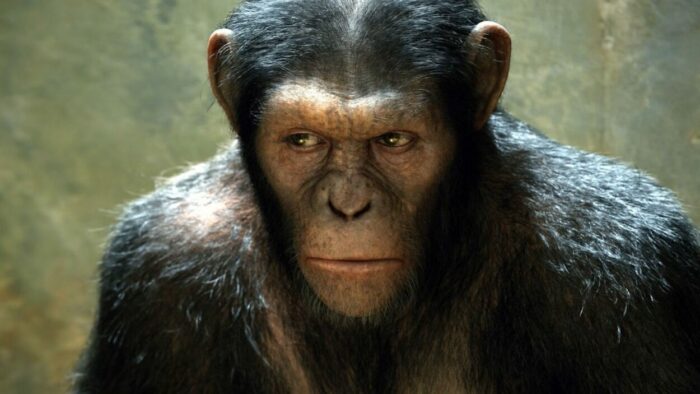
The first of the new prequels, Rise of the Planet of the Apes shows the full origins of the demise of the human race and beginnings of an intelligent ape society. In an attempt to cure Alzheimer’s, a scientist played by James Franco ends up creating a deadly virus instead, one that eventually wipes out nine-tenths of the human population. Before the virus began to spread, however, a young chimpanzee named Caesar was introduced to its effects, and was raised in a human environment by Franco, who isn’t particularly convincing as a scientist in this film but does come off as a warm father figure for the ape.
Rise perfectly balances entertainment and impending human dystopia throughout its breezy two hour runtime. Caesar is immediately a likable, sympathetic character, serving many similarities to the ape with his name in the original series. Right away, Caesar’s character development is so strong and emotional that he immediately becomes one of the best movie characters in recent years. From a baby chimp in a lab, to living in difficult circumstances in an ape sanctuary, to rising up against the humans and demanding freedom and rights for him and his fellow apes. His scream of “no!”, Caesar’s first spoken dialogue of the film, serves as an epic turning point for the story. In many ways, Rise of the Planet of the Apes is a perfect example of how to approach a prequel.
2. Dawn of the Planet of the Apes (2014)
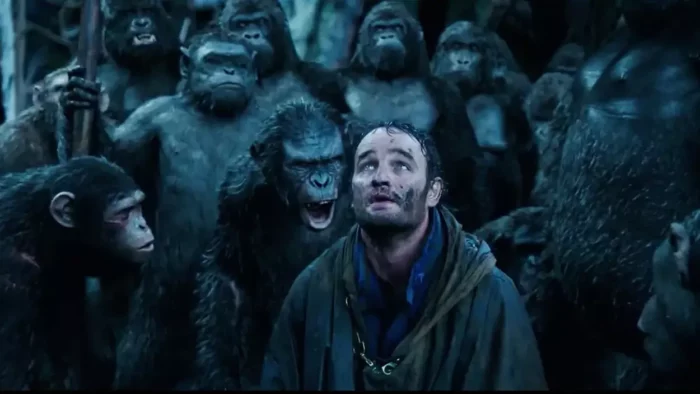
Dawn of the Planet of the Apes is arguably the best of the prequel trilogy of films as it takes the best elements from both its predecessor and its successor to achieve the perfect balance throughout. It’s emotional, even more so than Rise, particularly as Caesar’s character develops even further (he’s now a devout father and partner, and respected leader of his tribe). His bond with Maurice is also incredibly touching, with their friendship stemming back to the ape sanctuary in Rise and going all the way to Caesar’s last moments in War.
Dawn also introduces the iconic “apes together strong” saying, which perfectly encapsulates this film. Caesar is determined to maintain peace and unity amongst his followers, while also showing great mercy to the surviving humans. Once again, the question of just how different the humans and the apes are comes up once again, as does the comparison between two characters. On the human side is Gary Oldman, who is a determined leader that is ultimately wiling to do anything to keep the human race alive, and on the ape side is Koba, a bonobo with aspirations for power and whose anger towards those who experimented on him drives him to go to incredible lengths to destroy the humans. In showing Koba’s journey in Dawn, he becomes an iconic cinematic villain in the process. Matt Reeves sets up the perfect villain by having the audience sympathize with him, even if they don’t agree with his actions. Moreover, Koba is a great villain because he believes he’s in the right, showing similarities with the iconic Darth Vader in that regard. In a galaxy far, far away, Vader’s turn to the dark side is explained by his love for Padme and vulnerability to manipulation from Palpatine, so even as the audience wishes he didn’t head into that direction in Revenge of the Sith, his actions can still be described as realistic, as can Koba’s. In the real world, villains often aren’t aware they are the bad guys, with many actually believing themselves to the be hero instead. Koba is just that, and is also a perfect contrast to Caesar, making their rivalry just that more captivating in Dawn.
1. Planet of the Apes (1968)

The best is the first, after all. The original Planet of the Apes film succeeds in ways that few other films in history have, with a deeply thematic story that is also entertaining and compelling throughout. The iconic film features one of the best movie endings of all time, with the reveal that Charlton Heston’s Taylor has been on Earth the entire time, a fact he realizes as he sees the remnants of the Statue of Liberty buried in the sand on a beach.
Despite being set millions of years in the future, Planet of the Apes remains as successful of a commentary on the modern world as any film, a typical occurrence in the works of Rod Serling. Serling is best known for creating and writing The Twilight Zone, but his work on Planet of the Apes deserves to be highlighted as well. He was the one to introduce the idea of a destroyed Statue of Liberty and the writer that set the stage for the rest of the franchise’s success. Subversive in its willingness to conclude with such an abstract ending and tapping into raw emotions seldom explored in such depth, Planet of the Apes will remain a beloved classic for as long as movies are made.




